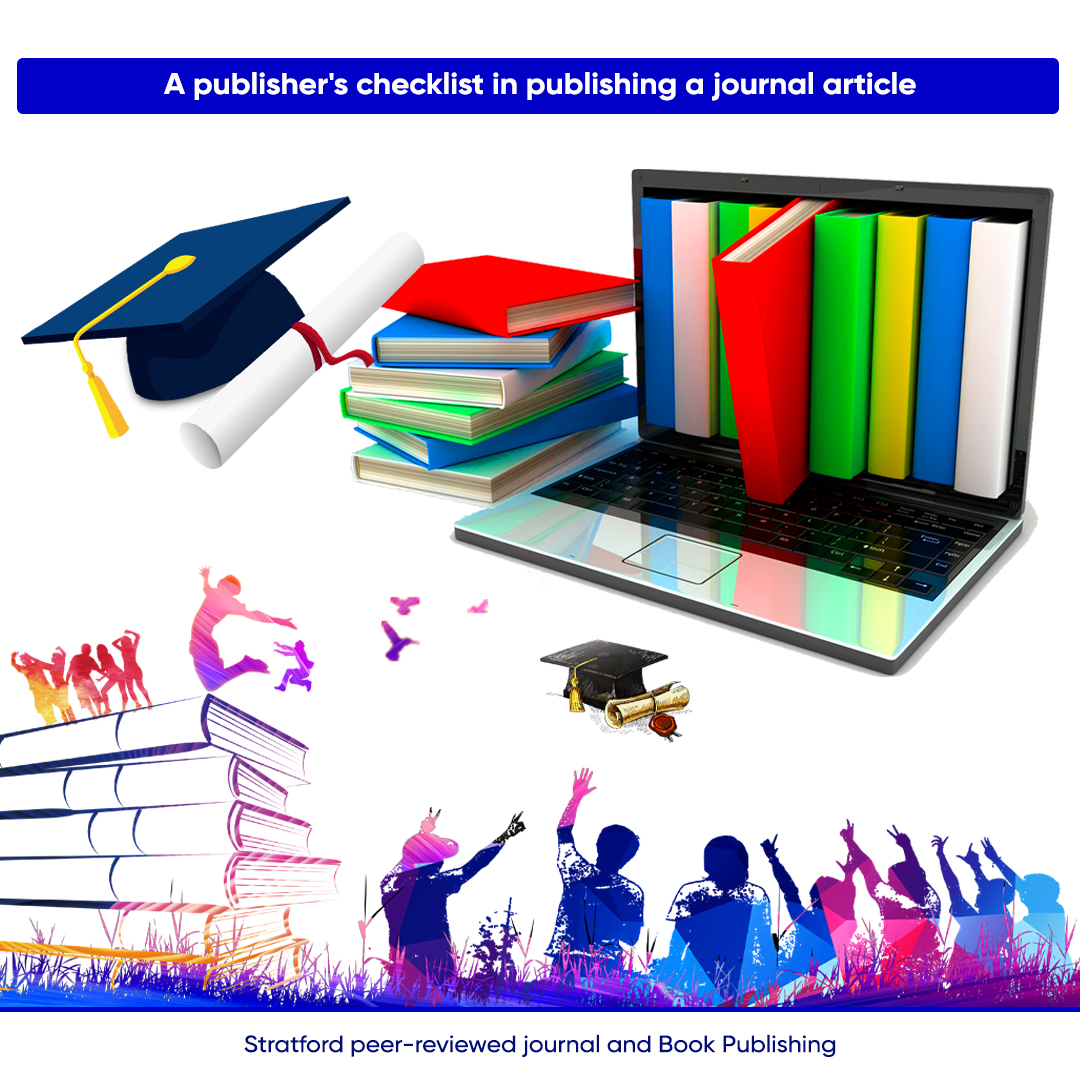
Publishing a Journal Article: Crucial Aspects
Publishing a journal article is sometimes a daunting process for postgraduate students, scholars, and other academicians. However, if you are familiar with the publisher’s checklist then this should be less difficult. Furthermore, because you have limited time and resources, it is essential to concentrate on work that journals are likely to accept. You may also be working with a team, so if you make the wrong choice, you will waste other people’s time. In this article, you will learn a step-by-step process of getting your research work on a reputable journal’s published list.
Why journal article publishing?
Reputation-building
Reputation-building is one of the reasons to publish. If you would like to become a reputable person in your field then publishing is essential. It could establish you as a respectable person in the field. The result of having your work in a journal could lead to permanent tenure in your institution, invitations to conferences, and even access to prestigious grants. You could become the go-to person for your research topic if you concentrate on a certain niche.
Solving Real-life problems
The main motivation for conducting research should be to solve a problem. This aspect is so important that it has a specific section in every research paper and is often highlighted in the abstract and cover letter. Journal editors with little time to read the entire script often go to the ‘research problem’ section to see whether the work merits consideration.
Confirming or disconfirming previous claims
Sometimes a certain topic may be so divisive and so confusing that it merits further investigation. If for example, people are arguing about whether male circumcision reduces sex drive, one research finding may reveal that it does. However, others may find no change in sex drive after circumcision while others may claim that it increases it. If research is inconclusive, it is helpful to do more research in that area so that you can settle the debate and contribute to knowledge.
The Procedure for Journal Article Publishing
1. Focus your publishing interest on the right area
No matter how well-written your work is, if it is not about useful topics, then it will not go far. Successful publication begins with focusing on ideas that are beneficial to society. It is essential to have a collective problem and work towards solving it. Therefore, do thorough research on what issues people are grappling with.
Common topics that society has been grappling with include:
- Infectious disease management
- Music therapy for depression
- The role of child abuse in mental health
- Learning disabilities in the inclusive classroom
- The impact of affirmative action in academia
- Government corn subsidies
- The correlation between abortion and fertility
Apart from picking relevant and disturbing topics, you do not want to repeat what someone else has done or merely conduct a study out of passion. It is permissible to focus on a similar research problem as other investigators. However, you must differentiate yourself by either adding new insights, resolve controversy, or expanding their work.
Alternatively, you may suffer from broad reach. If your research area is too wide, you may wind up being directionless. The ideas you generate could also be too shallow to be useful. Furthermore, no journal will accept something that wide-ranging. Be realistic about what you can accomplish within the time frame you have and other institutional constraints.
2. Choose the right publisher to consider in your publishing endeavor
Your research work may be meaningful and your process rigorous. However, if there is a mismatch between you and your publisher, they will reject your work. Settling on a journal that is both relevant to your field and interested in your kind of work is ideal. Consider reading their “call for applications” to determine whether your chances of going through are high. Find journals that are interested in your research topic.
You also want to select your targeted journal wisely because of their procedures. Every journal has their own publication processes that they display on their websites. If you want to heighten your odds of success then familiarize yourself with that process and follow it scrupulously. Ensure that your format is exactly what they want by reading sample papers in the journal. You should dwell on recent papers as the journal may have altered its guidelines over the years.
3. Avoid common research pitfalls that may delay your publishing
One of the reasons journal article publishing may fail is committing common research errors. Familiarizing yourself with these pitfalls could keep you from receiving that dreaded rejection letter. These pitfalls include:
- Exaggerating research impact
- Substandard data collection
- Plagiarism or fake results
- Self-reports
Exaggerating research impact: Some researchers want their material to appear groundbreaking. Therefore, even if their data is ordinary, they may be tempted to make it seem important. Furthermore, expanding research in a certain field is also another critical role that researchers play. Some studies are there to confirm findings so that other players may not commit research fraud. Consequently, do not fall prey to research exaggeration since even falsified hypotheses are useful in advancing knowledge in the field.
Substandard data collection: This practice may also contribute towards rejected manuscripts. If you are studying neck cancer for the Oral Oncology Report, there should be no point where you collect cervical cancer cells. In the above scientific journal, reviewers found that the researchers misidentified close to 30% of the cancer cell lines in the analysis. Therefore, they studied the wrong cancer, wasted time, and slowed findings that may have led to the treatment of neck cancer. The National Institute of Health has thus ramped up its scrutiny of scientific papers to ensure they did not contaminate cells or use cell lines. Therefore, you need to be quite careful whenever you are collecting data. Make sure that the field work or lab work measures what it purports and that your research method is replicable.
Plagiarism and falsification: Such behaviors are some of the gravest wrongs you can commit while attempting journal article publishing. Researchers can succumb to the pressure of producing impressive results. Therefore, they may intentionally and knowingly falsify their work. Alternatively, passing another person’s work as yours is unacceptable. Self-plagiarism is also becoming common as some people may use work they previously published to fill up their quota of pages. Avoid any of this dubious behavior if you do not want publishers to retract your journal article. Integrity is essential in protecting the public against policies or interventions that might harm rather than help them.
Self-reports: Relying on self-reports is also another reason why publishers will reject your work. You need to use other types of information that have valid instruments. Sometimes researchers use subjects’ self-reports as a basis of their findings. People often distort their reality to look better than they are. The American Society for Nutrition found that the purported calorific intakes by men and women in many self-report studies were practically impossible. Stay away from self-reports if you are measuring something quantifiable.
4. Write a high-quality manuscript
Although all paper publications have their own guidelines, certain criteria are common to all journal article publishing processes. These ideas include:
- A clear message
- Format
- Abstract and title
- Narrative
- References
You need a clear message when you are preparing your paper. Since the research adheres to a scientific process, then you should draft that message scientifically. Ensure that you express your ideas logically in a way that the editor will come to the same conclusion as you.
The format ought to adhere to the standards in a certain publication. However, on a general level, most papers start with a title and the author’s background. Then you may proceed to the abstract and introduction. The next chapters include method, discussion, results, references, appendices, and acknowledgements.
An abstract summarizes what you did; the introduction has the problem while methods explain how you solved the problem. Results explain what you found, the discussion explains their impact while acknowledgements mention who helped you. Lastly, your references mention the work you used while appendices contain additional information.
Once you complete your manuscript, work on your abstract and title. The title is the first opportunity to make a lasting impression. Make sure it captures your message while keeping it as succinct as possible. The abstract should also be specific and clear. The aim of these sections is to represent your research as accurately as possible.
Some people downplay references because they think they do not matter. However, incorrectly cited work has been many aspiring researchers’ downfall. Try and rely on scientific publications and do not use so much material from the same community. It could be authors from the same publications, funders, advisors, material suppliers, or regions. Strive to provide new material rather than overly rely on other people’s work. Finally, make sure that you do not misrepresent the references when you cite them. Read and understand them thoroughly.
5. Edit your material before presenting it for publication
It would be such a shame to spend all that time performing research then getting annulled because of grammatical errors. As the saying goes, to err is human, to edit is divine. Proofread every section of your paper several times. However, because individuals may be blind to their mistakes, take it to a professional proofreader to go through the manuscript.
Some websites or freelancers offer scientific editing services. They consider some stylistic aspects like line spacing and margins or formatting components like references. A second set of eyes may find mistakes that you may have overlooked. Some of the ideas in your draft may seem okay to you but could be less convincing to someone else.
Additionally, work with your supervisors at the tail end of the paper to ensure that everything meshes together seamlessly. Even though you may have worked with them on a chapter-by-chapter basis, it is essential to go back to them for the final paper. Working with more instructors could strengthen your ideas even more.
6. Your journal article’s cover letter
A cover letter means to journal article publishing what it means to a job interview. You need to highlight the most pertinent information about your research. Editors are the first gatekeepers, so convincing them is essential. While they may not out rightly reject your work because of a poorly written letter, they may develop serious doubts about the rest of the paper.
The first thing to include in the cover letter is your suitability. Explain to the editor why your paper would be ideal for their journal. Stress the synchronicity between your subject and the journal’s focus.
Next, add some research background material. Not everything will fit in your abstract so put it here. Even though the editor will see the cover letter before your abstract, it is better to write the cover letter after the abstract. Mention some controversies or unresolved issues in the field. Stay away from mentioning your professional accolades or other prestigious things this research has accomplished.
7. Submit to the journal and respond to the publication process
If you have adhered to all the processes above then you should be ready to submit. However, do one last perusal of other papers and ask yourself if the quality standards are similar. Send the paper to the intended publisher and wait. The paper might go for review depending on the corrections you might have. Some editors allow papers to go through with sufficient corrections yet others might not. Sometimes it is a matter of luck.
Do not be deterred if you face a rejection. Get the reviews that you receive and use them to improve your paper. Revise your first draft then submit it to another journal that fits your profile. You do not even have to consider a less prestigious journal after rejection. It is possible for high-impact publications to admit you when a less prestigious one rejected you. The focus should always be on the alignment between your subject matter and the journal’s focus area.
It may take a lot of time to make it into a journal. Sometimes the feedback you received may require you to go back to change earlier stages of your research paper. However, if you are thorough, it is likely that you may increase your odds of succeeding.
Looking Forward to Publishing a journal article
Journal article publishing is a systematic and rigorous process. Start by picking the research topic and identifying a journal that matches you area of interest. Conduct the research in an ethical and thorough way while avoiding common pitfalls. Prepare a manuscript with common research paper guidelines and the journal’s stipulations. Write an abstract, cover letter, and succinct title then submit the paper. Consider all the input you get in case you get rejected then apply again.

